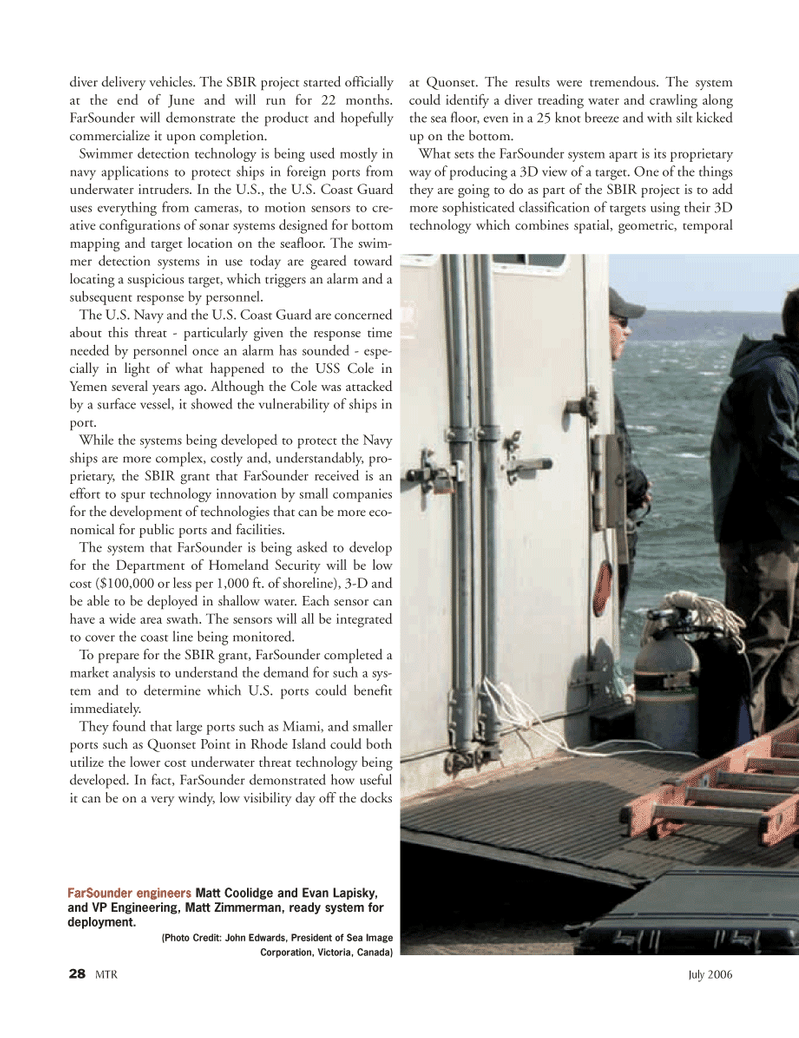
Page 28: of Marine Technology Magazine (July 2006)
Underwater Defense: Port & Harbor Security
Read this page in Pdf, Flash or Html5 edition of July 2006 Marine Technology Magazine
28 MTR July 2006 diver delivery vehicles. The SBIR project started officially at the end of June and will run for 22 months.
FarSounder will demonstrate the product and hopefully commercialize it upon completion.
Swimmer detection technology is being used mostly in navy applications to protect ships in foreign ports from underwater intruders. In the U.S., the U.S. Coast Guard uses everything from cameras, to motion sensors to cre- ative configurations of sonar systems designed for bottom mapping and target location on the seafloor. The swim- mer detection systems in use today are geared toward locating a suspicious target, which triggers an alarm and a subsequent response by personnel.
The U.S. Navy and the U.S. Coast Guard are concerned about this threat - particularly given the response time needed by personnel once an alarm has sounded - espe- cially in light of what happened to the USS Cole in
Yemen several years ago. Although the Cole was attacked by a surface vessel, it showed the vulnerability of ships in port.
While the systems being developed to protect the Navy ships are more complex, costly and, understandably, pro- prietary, the SBIR grant that FarSounder received is an effort to spur technology innovation by small companies for the development of technologies that can be more eco- nomical for public ports and facilities.
The system that FarSounder is being asked to develop for the Department of Homeland Security will be low cost ($100,000 or less per 1,000 ft. of shoreline), 3-D and be able to be deployed in shallow water. Each sensor can have a wide area swath. The sensors will all be integrated to cover the coast line being monitored.
To prepare for the SBIR grant, FarSounder completed a market analysis to understand the demand for such a sys- tem and to determine which U.S. ports could benefit immediately.
They found that large ports such as Miami, and smaller ports such as Quonset Point in Rhode Island could both utilize the lower cost underwater threat technology being developed. In fact, FarSounder demonstrated how useful it can be on a very windy, low visibility day off the docks at Quonset. The results were tremendous. The system could identify a diver treading water and crawling along the sea floor, even in a 25 knot breeze and with silt kicked up on the bottom.
What sets the FarSounder system apart is its proprietary way of producing a 3D view of a target. One of the things they are going to do as part of the SBIR project is to add more sophisticated classification of targets using their 3D technology which combines spatial, geometric, temporal
FarSounder engineers Matt Coolidge and Evan Lapisky, and VP Engineering, Matt Zimmerman, ready system for deployment. (Photo Credit: John Edwards, President of Sea Image
Corporation, Victoria, Canada)
MTR#6 (17-32).qxd 7/11/2006 8:51 AM Page 28

 27
27

 29
29
